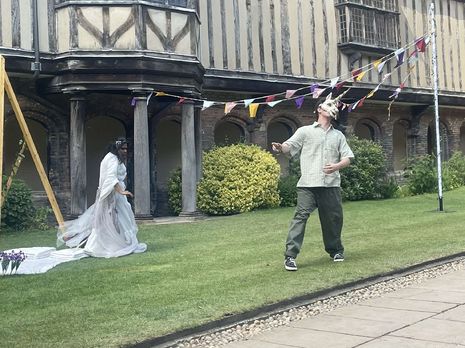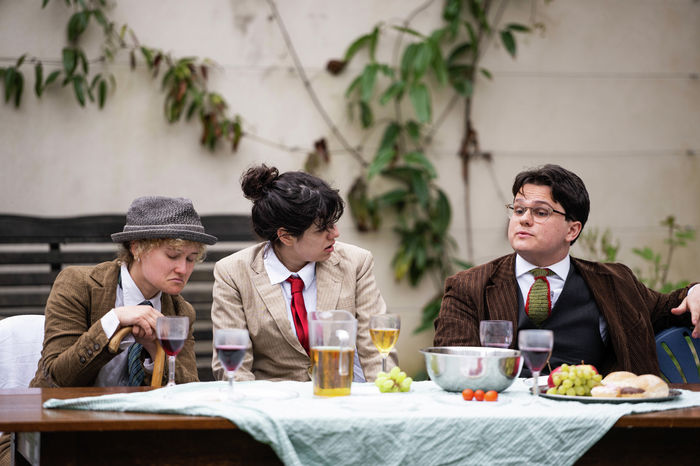Moments of enchantment in A Midsummer Night’s Dream
The metatheatrical Mechanicals are a strength of this production, which doesn’t make the most of its brilliant setting

Walking into Queens’ Cloister Court, exhausted and feverish after a night spent processing the most intoxicating Pimm’s ever to grace a subject garden party, I was gently roused to life by one of the most delightful outdoor Shakespeare setups I’ve seen in at while. You may gasp at my shocking behaviour – a self-respecting thespian, hungover during a performance of the Bard? But it was not so. I was simply dizzy and unknowingly desperate for cool squash, ice cream, and a plush red chair in which to sink. All were provided throughout the show by the obliging team of A Midsummer Night’s Dream.
The Cloister Court made for a romantically fitting backdrop, and this BATS production found its strength when it revelled in the joy of its site specificity. On the south side, a tiered rostrum provided auditorium-esque seating, with beanbags and blankets scattered around its edge. On the north side, divided from the audience proper by the stone path which runs through the centre of the court, the stage was set against timber Tudor walls inset with stained-glass windows. This sits above the cloisters themselves, demarcating a corridor with alcoves that were used to elusive and magical effect as action and transitions were partially visible to the audience: like looking through a window to glimpse a fleeting universe of garlanded sprites.
“Momentarily, the backstage became a fairy Otherworld”
Indeed, just before the play started three darting fairies rushed through this semi-visible tiring-house to then disappear behind the central cloister walls. Meanwhile a small band of musicians, criminally underused, played the audience into their seats – as the play truly began, these summery melodies seemed to summon the fairies from their hiding place. They reappeared through the pillars which jut out from the backdrop, each in a flowing white dress, rose-blushed makeup and “a coronet of fresh and fragrant flowers.”
Momentarily, the backstage became a fairy Otherworld, a spatial distinction which, if emphasised, would have made innovative use of the space. The opportunity was missed as staging got a bit muddled – barefooted fay did indeed linger behind pillars and lean out of alcoves, beadily watching the action, but Oberon and Titania often entered from elsewhere and the cloisters were eventually given up to the Rude Mechanicals. However, this sharing of space does draw some intriguing parallels between the play’s meta-theatricals and its supernatural elements. Puck overtly directed and choreographed the action when he lifted his misdirected love spells with a theatrical click of the fingers, and the lovers themselves became gradually more fairy-like as they let down hair and lost shoes scrambling through the woods.
“The main plot of the lovers’ magical befuddlement was plodding”
The setting promised exuberance that matched the sun – this first performance coincided with a particularly glorious summer solstice. Such folk-magic undertones lent enchantment to the maypole wound with ivy and strung with bunting. But it seemed that both the language and outdoor grass stage became a pitfall. The main plot of the lovers’ magical befuddlement was plodding and lacked dynamism. As the blocking was consistently linear, there was nothing very visually interesting to engage the eye while the actors rattled off lines of dialogue. The exceeding width of the stage must have also been a tad overwhelming. No actor could quite generate power or control over their performance while attempting to traverse the stretch of grass, and exits often became unintentionally comical.
Though much of the humour was lost to static staging and dense dialogue, Rob Monteiro’s Lysander provided welcome relief. Even as he stumbled and flinched, he possessed a particular nimbleness that twisted the character’s sheer wimpiness into something unusually endearing, hitting almost every comedic mark. And the pace, dragging for most of the performance, finally picked itself up as the spellbound lovers clashed in the swell of the second act, finding intensity in their snappy interactions.
All this served to enhance the refreshing vibrancy of the Dream’s Mechanicals – the subplot’s tinkering troupe of amateur actors. Federico Lucas as Bottom was a master of the stage, whether effortlessly hopping between characters and voices or hitting every beat of Pyramus’ hilariously protracted death. Of course, he was paralleled only by his fellow Mechanicals, all too brilliant to put into words here, whether moon, lion, or wall. In particular, Betty Blythe’s Quince was the perfect counterweight to Bottom, both hilarious and endearing in her own right. And Noah Hammond as Flute made a charmingly twirling Thisbe, constantly filling the stage with warmth while waving at the audience.
It was somewhat ironic that as the Mechanicals imitated and dissected the theatrical world they were enclosed within, they produced a performance that far surpassed their romantic and magical counterparts. Indeed, this was a play dominated by gaps admirably patched up by its stronger elements, be it a revivifying B-plot, or absent music understudied by the chirping birdsong arias which filtered in from behind our seats.
 News / Candidates clash over Chancellorship25 April 2025
News / Candidates clash over Chancellorship25 April 2025 News / Cambridge professor paid over $1 million for FBI intel since 199125 April 2025
News / Cambridge professor paid over $1 million for FBI intel since 199125 April 2025 Interviews / Dr Ally Louks on going viral for all the wrong reasons25 April 2025
Interviews / Dr Ally Louks on going viral for all the wrong reasons25 April 2025 Comment / Cambridge students are too opinionated 21 April 2025
Comment / Cambridge students are too opinionated 21 April 2025 News / Zero students expelled for sexual misconduct in 2024 25 April 2025
News / Zero students expelled for sexual misconduct in 2024 25 April 2025






